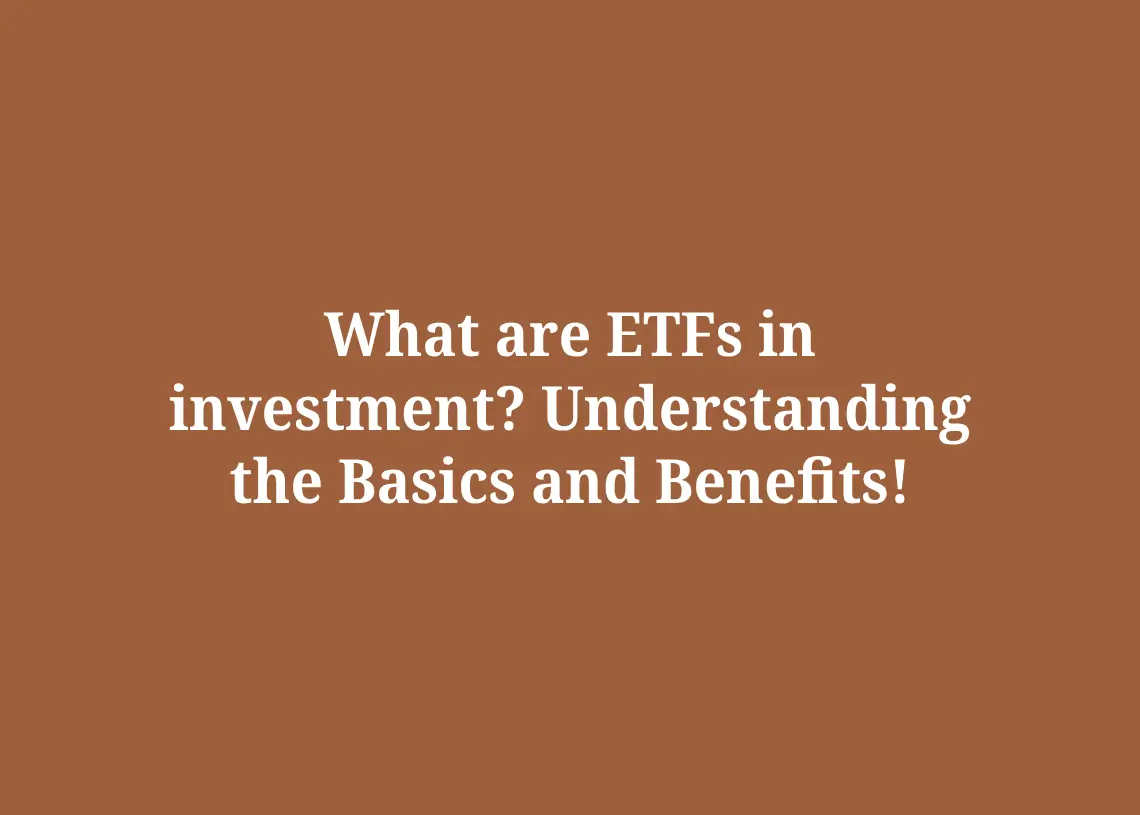Investing can be a daunting task for those who are new to the world of investments. While there are several options to choose from, Exchange Traded Funds (ETFs) have become increasingly popular among investors. ETFs offer a convenient and cost-effective way to invest in a diversified portfolio of assets. These funds trade like stocks on stock exchanges and can be bought or sold throughout the day.
If you are a beginner investor, or simply curious about the benefits of ETFs, this blog post will provide you with a comprehensive understanding of what ETFs are and how they work. We will cover the basics of ETFs, including how they are structured, the different types of ETFs available, and the benefits they offer to investors. Additionally, we will examine how ETFs can be used to build a diversified portfolio, as well as potential risks and considerations to keep in mind when investing in these funds.
ETFs are exchange-traded funds
ETFs, or exchange-traded funds, are a type of investment fund that is traded on stock exchanges, much like individual stocks. It’s offer investors a way to diversify their portfolios by investing in a basket of assets, such as stocks, bonds, or commodities.
These funds are designed to track the performance of a particular market index, sector, or asset class. ETFs are popular among investors because they offer the benefits of both mutual funds and individual stocks. They are easy to trade, have low fees, and provide instant diversification. Additionally, ETFs offer tax advantages and transparency, since they are required to disclose their holdings on a daily basis.
Overall, ETFs are a versatile and convenient investment option for those looking to build a diversified portfolio and manage their risk exposure.
They track a specific index
One of the benefits of investing in Exchange-Traded Funds (ETFs) is that they track a specific index. An ETF is designed to mirror a specific benchmark index, such as the S&P 500 or the Dow Jones Industrial Average. By investing in an ETF, investors can gain exposure to a broad range of companies in a particular index.
This can help to diversify a portfolio and minimize risk. Additionally, ETFs typically have lower fees compared to actively managed mutual funds, which can eat away at investment returns over time. As such, ETFs have become an increasingly popular investment option for both novice and experienced investors looking to build a diversified portfolio.
ETFs are bought and sold
One of the primary benefits of investing in ETFs is their ease of buying and selling. ETFs are traded on stock exchanges similar to individual stocks, which means they can be bought and sold throughout the trading day at market prices.
This provides investors with the flexibility to adjust their positions quickly in response to changing market conditions or investment goals. In addition, ETFs can be bought and sold through a variety of channels, including online brokerages, financial advisors, and robo-advisors, making them accessible to a wide range of investors. With their low costs and high liquidity, ETFs are an attractive investment option for both individual and institutional investors looking to diversify their portfolios.
They offer diversification benefits
One of the key benefits of investing in Exchange-Traded Funds (ETFs) is that they offer diversification benefits. ETFs contain a basket of assets, such as stocks, bonds, or commodities, allowing investors to gain exposure to a variety of different markets and sectors, thus spreading their risk and potentially reducing overall portfolio volatility.
With ETFs, investors can buy into a broad index or sector, or even gain exposure to specific themes or niches, such as renewable energy or emerging markets. By providing access to a diverse range of investments in a single trade, ETFs can provide significant portfolio diversification benefits for investors seeking to build a well-balanced investment portfolio. Additionally, ETFs can be bought and sold throughout the trading day, providing investors with greater flexibility and liquidity compared to traditional mutual funds.
They have low expense ratios
One of the key benefits of investing in ETFs is their low expense ratios. These ratios are the annual fees charged by the fund to cover operating costs, and they are generally much lower than those of actively managed mutual funds.
ETFs are passively managed, meaning they track a specific index or market sector rather than relying on a portfolio manager to select individual stocks. This results in lower operating costs and, subsequently, lower expense ratios for investors.
With lower expense ratios, investors keep a larger portion of their investment returns, which can lead to significant savings over time. Additionally, low expense ratios make ETFs an attractive option for long-term investors seeking to maximize their returns and minimize their costs.
ETFs are tax-efficient investments
One of the significant benefits of Exchange-Traded Funds (ETFs) as investment vehicles is that they are tax-efficient. ETFs are structured in a way that minimizes taxable events, which translates to lower tax liabilities for investors.
Unlike mutual funds, ETFs typically have low portfolio turnover rates. This means that ETFs generate fewer capital gains, which are generally taxed at a higher rate than other types of investment income. Moreover, ETFs allow investors to take advantage of tax-loss harvesting strategies, where they sell losing positions to offset gains in other investments.
By doing so, investors can minimize their tax liabilities while still maintaining their investment objectives. Overall, ETFs provide investors with a tax-efficient way to invest in the stock market, which can be an essential consideration for long-term investment planning.
They offer flexibility in trading
One of the key benefits of exchange-traded funds (ETFs) is that they offer flexibility in trading. Unlike traditional mutual funds, ETFs trade on an exchange like a stock, which means they can be bought and sold throughout the trading day.
This allows investors to take advantage of market fluctuations and adjust their portfolios in real-time. Moreover, ETFs can be bought on margin or sold short, which means investors can use leverage to amplify their gains or hedge against losses.
This flexibility in trading makes ETFs an attractive option for active traders and investors looking to create a customized and diversified portfolio. Additionally, since ETFs are traded like stocks, investors can use a variety of trading strategies, such as limit orders and stop-loss orders, to manage their positions and minimize risk.
ETFs can be used for short-term or long-term investments
ETFs, or exchange-traded funds, have become increasingly popular among investors due to their flexibility and potential for diversification. One of the key benefits of ETFs is that they can be used for both short-term and long-term investments.
Investors who are looking for short-term gains can use ETFs to take advantage of market fluctuations and quickly buy and sell shares. On the other hand, investors who are looking for long-term investments can use ETFs to build a diversified portfolio that can grow over time.
Additionally, ETFs offer lower fees compared to other investment options such as mutual funds, making them an attractive option for both short-term and long-term investors. It is important to note, however, that as with any investment, there are risks associated with ETFs and investors should do their due diligence before making any investment decisions.
They offer exposure to sectors
One of the benefits of investing in ETFs is that they offer exposure to sectors. ETFs are designed to track specific sectors, such as technology, healthcare, or energy. By investing in an ETF that tracks a particular sector, you can gain exposure to the companies within that sector without having to pick individual stocks.
This can be particularly beneficial if you want to diversify your portfolio and reduce your risk. Additionally, ETFs can give you access to sectors that may be difficult to invest in otherwise, such as emerging markets or specific industries. Overall, investing in ETFs can be a smart way to gain exposure to a variety of sectors and diversify your portfolio.
ETFs can be used to hedge
One of the benefits of investing in Exchange Traded Funds (ETFs) is that they can be used as a tool for hedging. Hedging is a risk management strategy that involves taking an offsetting position in a financial instrument to protect against potential losses.
ETFs can be used to hedge against the volatility of other investments in a portfolio. For example, an investor who holds a large position in technology stocks may choose to invest in an ETF that tracks a broad market index like the S&P 500 to offset potential losses in the event of a market downturn.
This can help to mitigate risk and protect the overall value of the portfolio. However, it is important to note that using ETFs for hedging purposes involves additional costs and may not always be an effective strategy depending on market conditions.
Conclusion: What are ETFs in investment? Understanding the Basics and Benefits!
In conclusion, exchange-traded funds (ETFs) are a popular investment vehicle due to their flexibility, diversification, and low costs. ETFs have become a viable alternative to traditional mutual funds, offering investors exposure to a variety of asset classes and investment strategies.
With ETFs, investors can easily and efficiently build a diversified portfolio tailored to their investment objectives and risk tolerance. Additionally, ETFs provide investors with liquidity and transparency, making it easier to trade and monitor their investments. Overall, understanding the basics and benefits of ETFs can help investors make informed investment decisions, leading to potential long-term growth and financial success.




